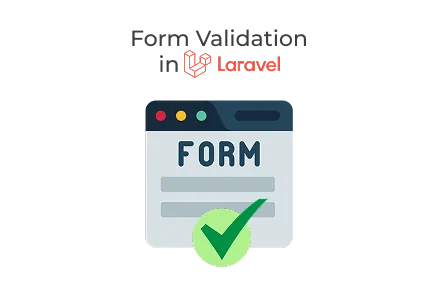Home - Scripts - Website Development

Laravel’s validation system drives 65% of PHP web apps, cutting security flaws and errors, which is important for modern development.
Key Points
Laravel offers a clear, fluent API for validating user input. Whether creating simple forms or complex data workflows, strong validation is important for maintaining data integrity, avoiding security risks, and ensuring a smooth user experience. In Laravel, validation logic can be implemented in controllers, custom Form Request classes, or directly in views for smaller projects (though this is not recommended for large applications).
This guide focuses on controller-based validation while covering best practices for displaying error messages to users. If you’re involved in custom web development services or planning to hire Laravel experts, mastering validation is crucial for creating professional-quality applications.
The simplest way to validate data in Laravel is by using the validate() method directly in your controller actions. This method automatically:
checks incoming request data against your defined rules,
redirects back to the previous page on failure,
flashes old input data to the session, and
Makes error messages available to your views.
Create a controller method like this:
If validation fails, Laravel automatically redirects back with error messages. This workflow makes it incredibly efficient for developers building custom website solutions.
Here’s a Blade template form (Form.blade.php) to submit the user registration data:
Note the use of {{ old('field') }} to repopulate fields after a validation failure—an essential feature for user-friendly forms.
Laravel comes with a wide range of built-in validation rules for different data types and requirements. Here’s a quick reference:
required: The field must be present in the input and should not be empty.
string: The input must be text. Numbers, arrays, or other types will not be accepted.
email: The value must be a valid email format like example@domain.com.
min:n: The input must be at least n characters long (for strings) or contain at least n items (for arrays). For example, min:5 requires a minimum of 5 characters.
max:n: The input must not exceed n characters or items. For example, max:10 allows up to 10 characters.
confirmed: The input must have a matching field with _confirmation at the end. For example, if you're validating password, you also need a password_confirmation field, and both must match.
unique:table,column: The input must not already exist in a particular database table and column. For example, unique:users,email means the email must be unique in the users table's email column.
regex:/pattern/: The value must match a specific regular expression pattern. This is used for custom formats, like phone numbers, usernames, or postal codes.
Laravel’s flexibility allows you to mix and combine these rules for precise validation. For example:
Once validation errors occur, Laravel automatically stores them in the $errors variable accessible in all Blade views. You can display error messages globally or on a per-field basis.
This snippet shows a list of all validation errors at once:
This is perfect for generic error summaries on your forms.
To display an error only for a specific field, use the @error directive:
This technique provides fine-grained control for custom form layouts.
By following these techniques, you’ll implement robust, user-friendly form validation in Laravel applications. Whether you’re delivering custom web solutions or looking to hire Laravel experts, understanding Laravel’s validation system is critical for building secure, maintainable applications.
Laravel makes it straightforward to:
Validate user input
Protect your application from bad data
Deliver clear error feedback to users
Master these practices, and you’ll significantly enhance the quality and professionalism of your web development projects.

©2025Digittrix Infotech Private Limited , All rights reserved.